
The Indonesian heritage Museum is an Indonesian cultural heritage museum that has a collection of cultural heritage from all over Indonesia, founded in 2010, the Indonesian heritage Museum is also a pioneer of museums with Augmented Reality technology in Indonesia, there are 17 zones representing regions in Indonesia, which store historical objects from all tribes in the country.
We ask visitors to be able to download the Augmented Reality application on the Google Play Store and also the Autoself Guided Tour which can be accessed via the website to make it easier for visitors while at the Indonesian Heritage Museum.
AUSTRONESIA
Funnel Axe
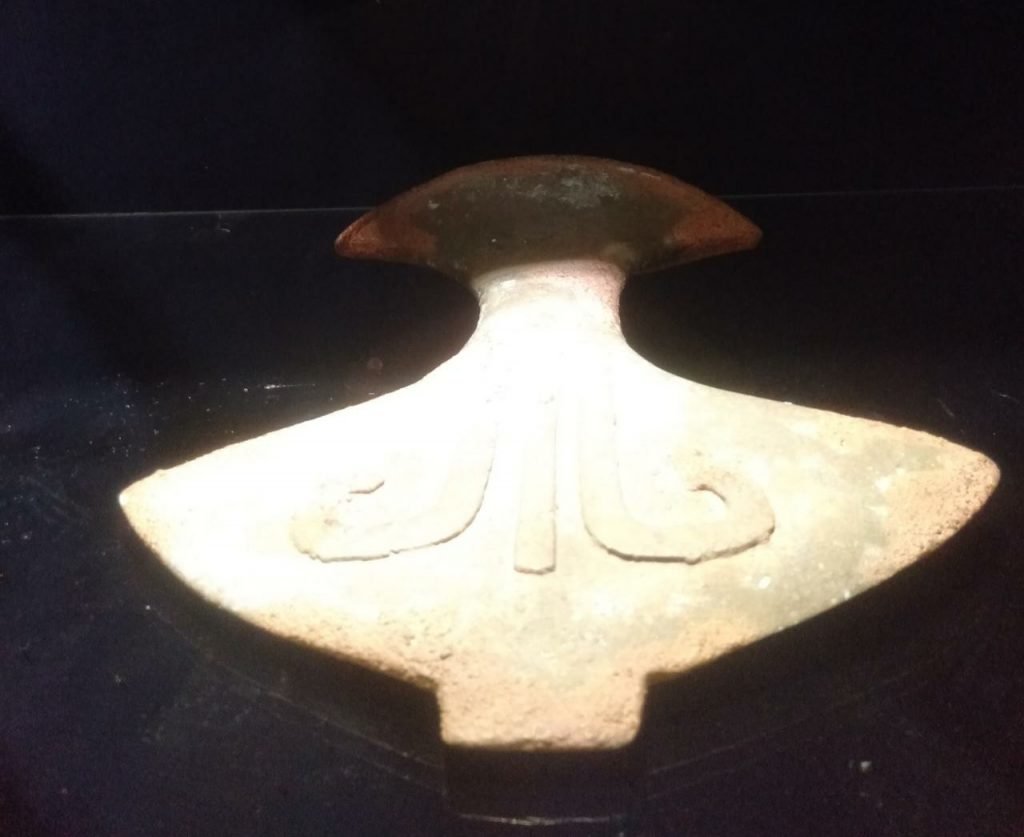
The funnel axe is an ax used by ancient people for farming, a shape resembling an ancient hoe that can help the community to cultivate fertile land to produce various kinds of food ingredients, especially tubers. This funnel ax comes from the Dongson culture in northern Vietnam and is found in the interior of Java.
Ancient Bracelet

In the past, bracelet accessories were used not only for beauty but also as a marker of social status in society. Large and heavy ancient stone bracelets indicate high social status in society. The meaning of the ancient bracelet used by the community apart from showing social status is also used to mean that the user does not have to bother carrying out activities like ordinary people because they wear heavy objects and make sure they have servants.
Head Statue
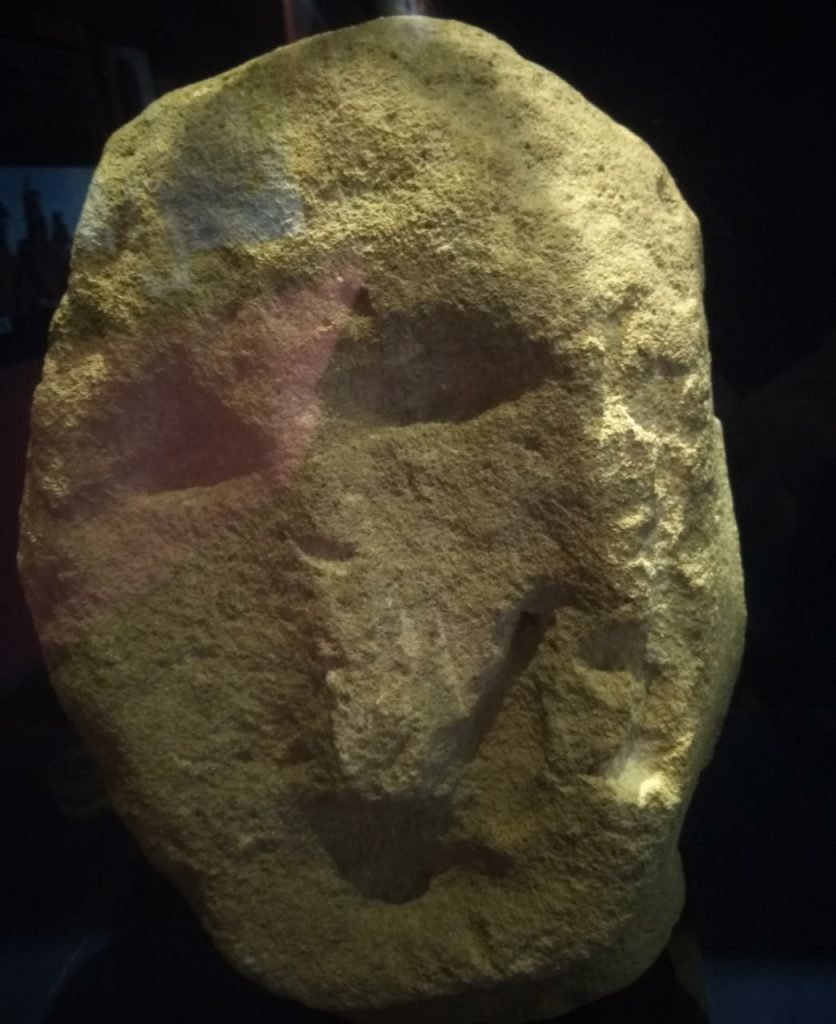
Head statues are ancient statues in the form of human heads used by animist dynamism as a ritual tool to worship ancestral spirits. Because of the shape of the head with naturally formed eyes and lips, people think that this head statue is also an incarnation of the spirits of their ancestors, this statue was found on the coast of the island of Java.
Old Tribal Figure

This old tribe figure is a picture of old tribes in the past that have disappeared from civilization. In ancient times there were many other tribes that were different from today but could not survive because of the onslaught of inter-tribal wars and other things, the tribes that lived in the Austronesian period already had a high artistic civilization and were skilled in agriculture and many things.
Chandrash’s axe
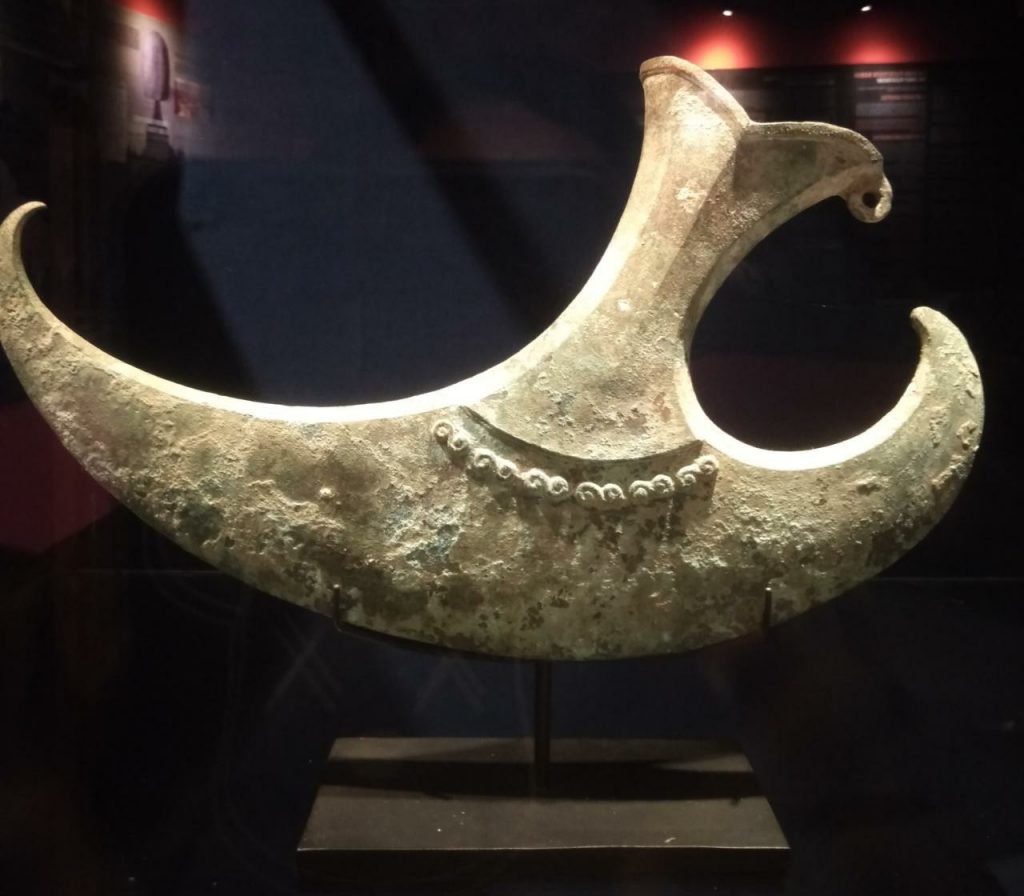
The Candrasa axe or what is often also called the shoe ax is an ax used for the purposes of traditional rituals of the animist dynamism community, namely people who still do not know religion and still have a belief system in ancestral spirits. This ax is made of bronze and comes from the Dongson culture in northern Vietnam, which culture was the forerunner to the creation of various tribes in Indonesia.
MAJAPAHIT
Terracotta Figure

Terracotta figures enshrined in the era of the Majapahit kingdom, terracotta is clay that was burned and formed various kinds of tools that function in everyday life and are also shaped to resemble the faces of famous figures in that royal era.
Temple of Bajang Ratu

Bajang Ratu Temple is located in the Trowulan area, Mojokerto. The bajang Ratu gate is the entrance to the Majapahit kingdom. The kingdom triumphed in the 13th century under the leadership of Hayam Wuruk and Mahapatih Gajahmada. Until now, one of the remaining remains of the Majapahit royal palace is the Bajang Ratu Gate which is also a tourist destination.
Ancient Piggy Bank

An ancient piggy bank in the form of a fat pig found around Trowulan Mojokerto, this piggy bank is used as a bearer of blessings for residents of the house, this terracotta piggy bank is also used as a souvenir when visiting distant relatives.
Copper Princess Mirror

Princess mirror made of copper is used by members of the royal family to make up themselves, the quality of the copper used is the best so it can give the best reflection too. Usually, princess mirrors are also gifts for palaces that have princesses or royal concubines who are beautiful and like make-up.
Gold Print

Gold molds were used by the people of the Majapahit era to print liquid gold which served as a medium of exchange in buying and selling, the amount of gold was adjusted according to the amount of negotiations between traders or it could also be used as a gift.
East Java
Place of Medicine

This medicine cabinet is used by the healer to bring the medicine to the patient’s house, the available drawer is the price level and the properties of the medicine that will be used by the healer to treat the patient, the medicine used usually consists of herbal medicines from various kinds of plants.
Miniature Cow Race

Karapan sapi is a native Indonesian culture originating from Madura, at the beginning of the story it was used to entertain princes who were heartbroken but later became a culture that was so loved by the Madurese.
Loro Blonyo Probolinggo
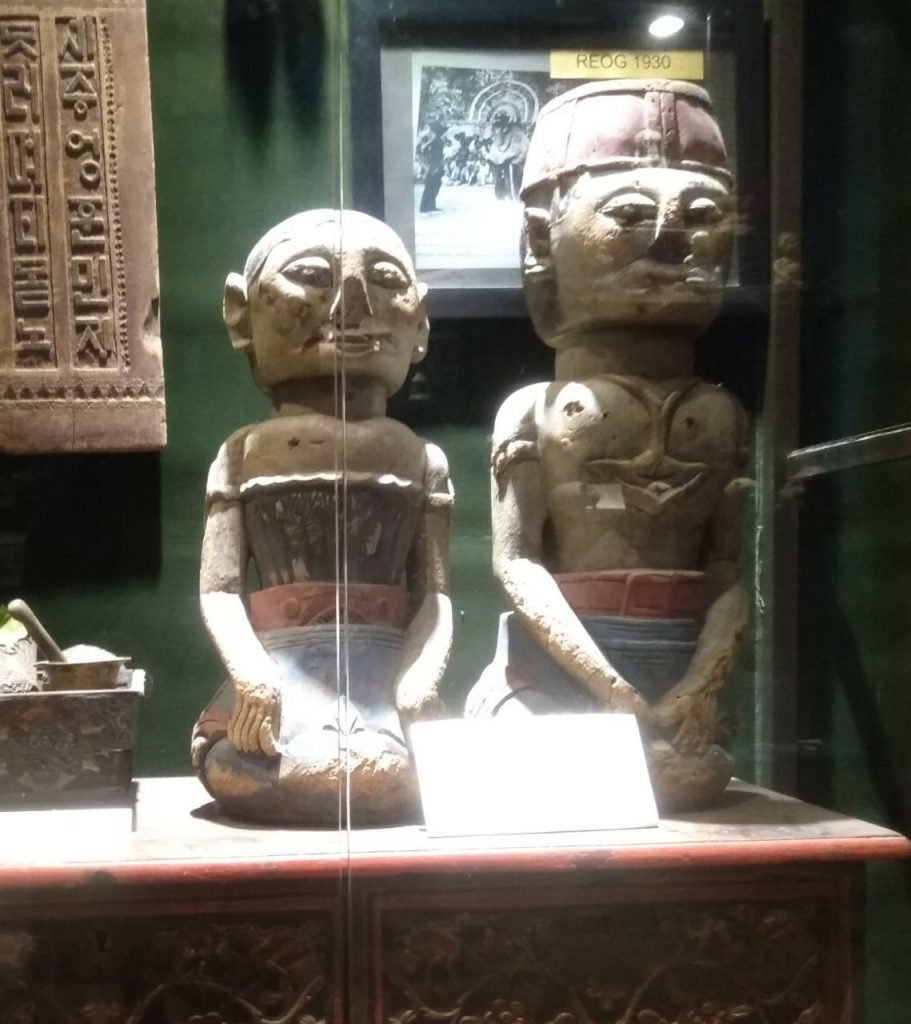
Loro Blonyo is a symbol of domestic happiness, this statue of a married couple means about the life of a married and happy husband and wife. The Loro Blonyo statue is taken from the Javanese language Loro and Blonyo or two people who make up because they are going to be brides.
Curtain Decoration

Sampiran Curtain decoration in the form of a sea fairy is a cultural heritage object from East Java which functions to hold the bamboo that becomes the Sampiran curtain cloth, this decoration means blessings and happiness in the house.
CENTRAL JAVA
Genteng Wuwungan

The Wuwungan tile is a symbol of a blessed house in ancient Javanese times, a house on which there is a wuwungan / decoration is believed to bring happiness to the occupants of the house, the wuwungan mother symbolizes how important the figure of a mother is to protect the family.
Spear

In ancient times, the palace spears were used for war and as weapons for soldiers who defended the palace and maintained the security of the entire Solo palace area, but nowadays the palace spears are used as a marker of the status of royal relatives, which can be found in the living room of the palace relatives.
Drama Mask

The mask of early contemporary drama in modern society depicts thick lips, namely the government elites who only make sweet promises to their people. Drama performances are usually performed by youths, just like the demonstrations that are being carried out by students today.
Tiger Mask

This mask depicts a singo barong and a ferocious tiger brought by the king of klono sewandono in order to face enemies who were blocking him from getting Dewi Songgolangit as his wife.
Betel Place

The betel place is a betel container for ancient Javanese society, the shape of each region is different, the gold color that is there depicts beauty and majesty, betel is used as medicine and also for dental health.
West Java
Gambling Dice

Gambling dice are used by the Chinese Javanese to gamble and predict trade fortunes. The number of animals and colors symbolize the meaning of various bad and good things that will happen, the large shape makes it easier to play, and minimizes mistakes in interpreting the marks on the dice.
Blawong
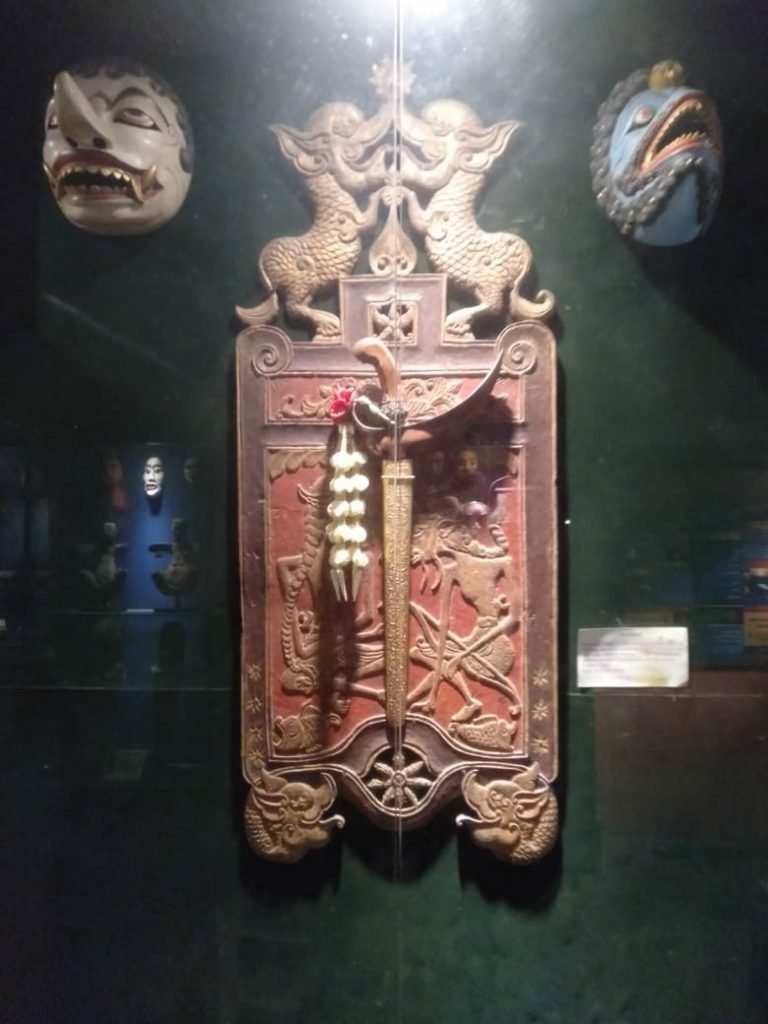
Blawong is a place to hang a keris with ornaments that contain a certain meaning, usually blawong is made by a certain kingdom or area for the kingdom to be visited, and combines the two royal cultures, such as Blawong from Chinese and West Javanese culture, as seen from the image of the kilin and wayang.
Palace Makeup Glass
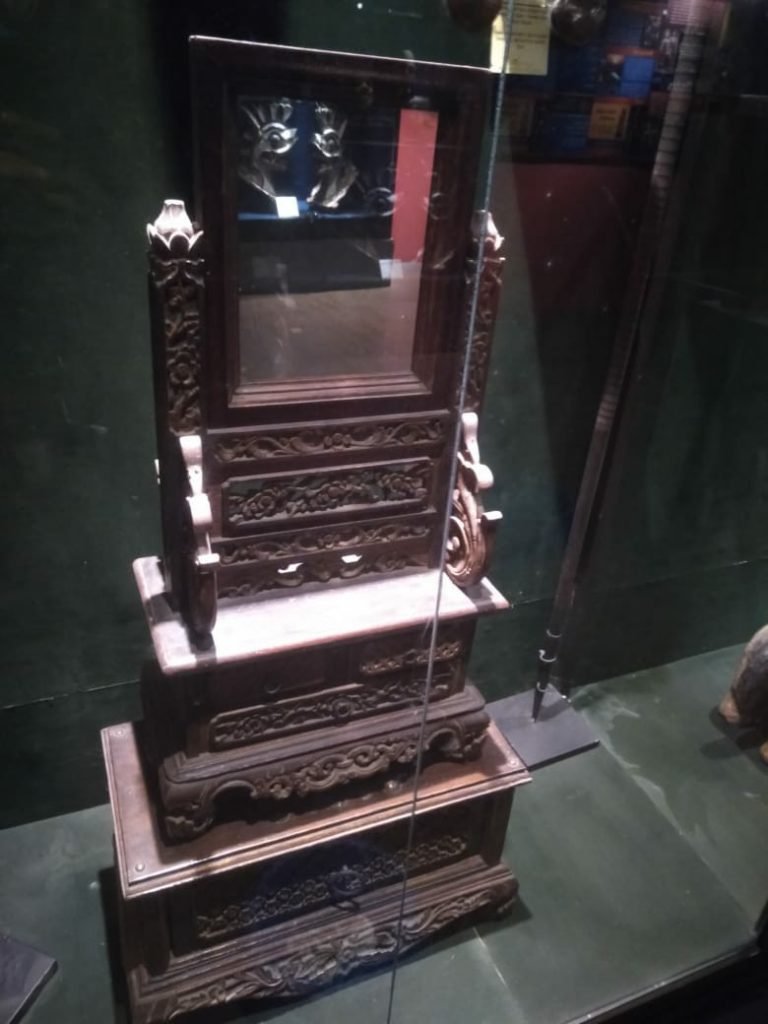
This makeup mirror belongs to the palace of West Java which is used by its empress / female family members to store their make-up and gifts and jewelry, beautiful carvings symbolize that this object cannot be owned by just anyone.
Buto Terong Mask

This mask is a mask that tells the story of a buto (giant) character who has an eggplant (big) nose, this giant likes to help build the kingdom quickly but asks for wages to be given the most beautiful woman as a gift, if not given then buto eggplant will be very angry and destroy the kingdom.
Milk Jug

This jug is in the shape of a woman’s breast so it is called a milk jug, used for drinking water containers and signifies fertility and health and freshness of the body, milk jugs in ancient times were commonly found in the homes of soldiers
BALI
Rangda
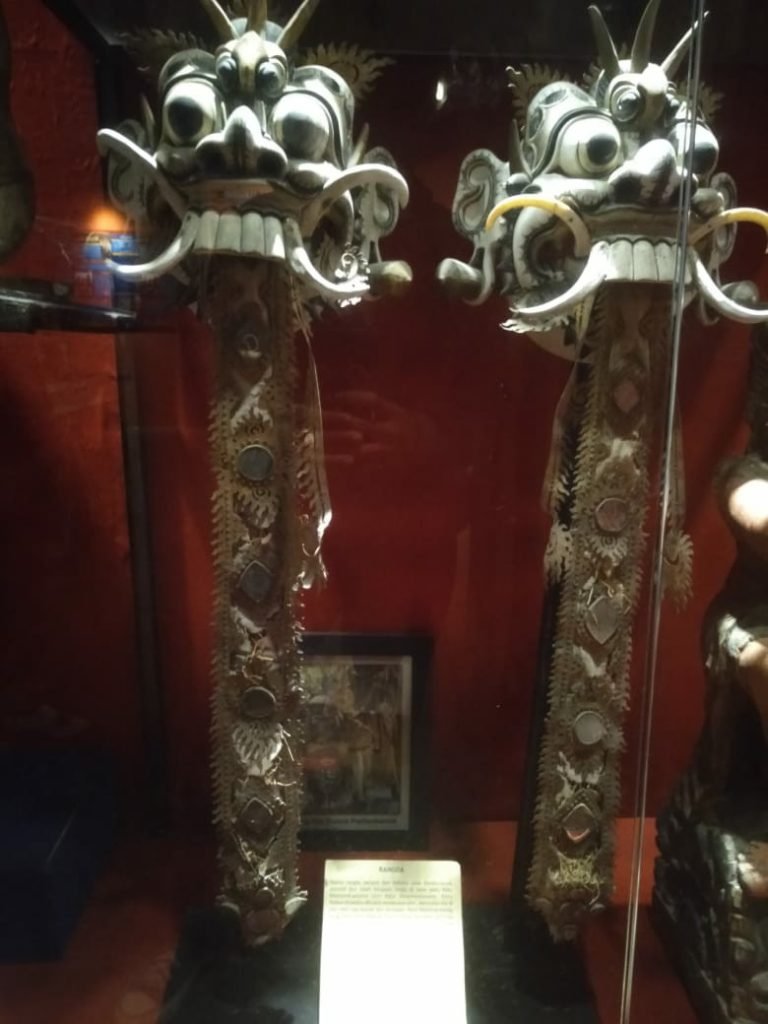
Rangda is a ghost figure in Balinese legend, a manifestation of Calon Arang which depicts evil and havoc. Rangda is described as resembling an evil giant with a head that can be separated from the body and a tongue so long that Rangda uses it as a weapon in doing bad things, for example, eating babies.
Singaraja Statue

The Singaraja statue is a statue of safety and blessing for the people of Bali, the Singaraja statue is used as a mascot or statue of a welcome symbol in several public facilities such as terminals, ports and government service offices.
Old Mask

An old mask is a mask depicting a respected figure by the community or an elder who is full of advice. Old masks are usually used for traditional Balinese ritual dances. The making of these old masks must also go through several stages of sacred Balinese customs.
King’s Throne Chair

This chair made of iron and steel is the royal throne of Buleleng, the motif of the throne in the form of a peacock symbolizes majesty and beauty. The king’s chair is made not too high which means social inequality between the king and the people, so that the people can still convey their aspirations directly.
Garuda Wisnu Kencana statue

This statue depicts the valor of the god Vishnu when riding an eagle, this statue is used as a symbol of the aesthetic island of Bali, the god Vishnu is one of the highest gods in Hinduism, a religion that is also followed by the majority of the population.
WEST NUSA TENGGARA
Jaran Kamput

Jaran Kamput is a mythological horse from the Lombok region called Sekardiu, Sekardiu is the vehicle of the gods which means strength and valor, Jaran Kamput is used as an art / tool to parade boys who are about to be circumcised so that they are blessed and acquire the good qualities of Sekardiu.
Kemanten Horse
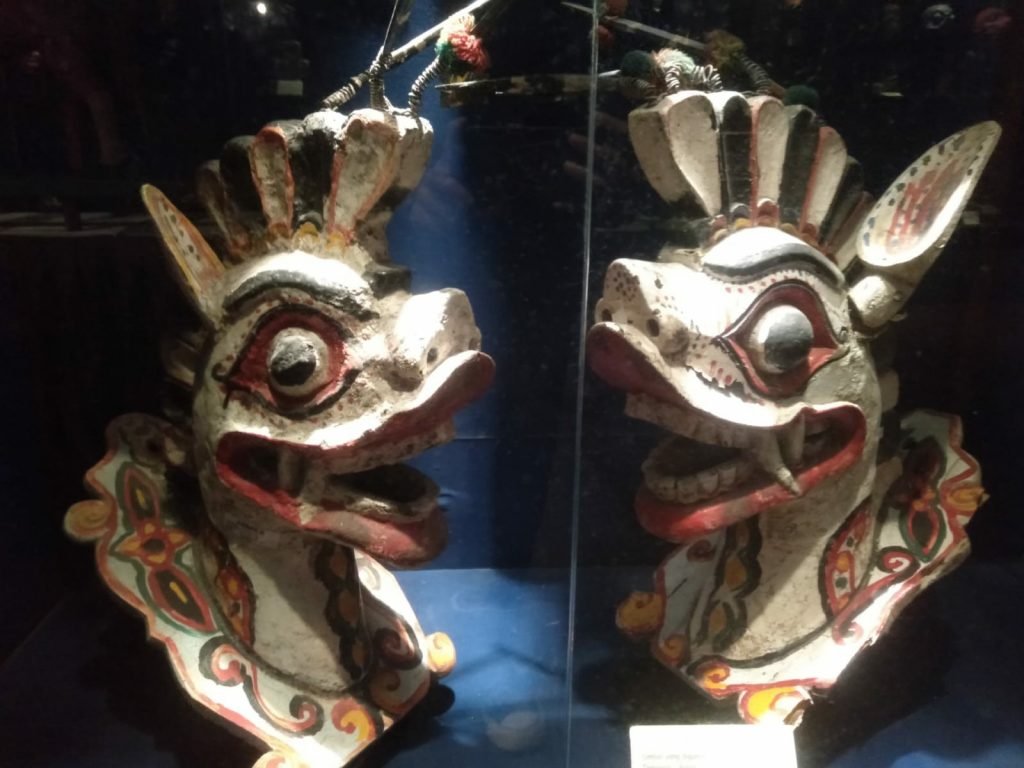
The Kemanten horse is a horse which is a symbol of the existence of a wedding party in a village in Lombok, the Kemanten horse is described as a pair of horses who are happy to welcome guests who are invited to the wedding so that they can feel the happiness of the bride and groom.
Village Guardian Statue

This village guard statue is a statue that resembles two people standing at the boundary of the village. This statue is believed to protect the village from the evil of other villagers who come to injure, so that anyone who comes to the village will pass by the statue and be blessed, if it has evil intentions then it will not be able to leave the village in good condition.
King Bird Cage

This bird cage belonged to kings / officials in ancient times because it can be seen from the existing ornaments, namely the dragon which is an ornament belonging to people with high caste, this bird cage is a place for pet birds placed in magnificent houses / palaces.
Drama Mask

This mask is used to play drama stories of the Sasak indigenous people which are quite well known, usually Sasak dramas tell the story of amaq (father) which is popular with the community, the masks of the Sasak drama have characteristics, namely expressive faces and rattan bags used to store these white masks.
EAST NUSA TENGGARA
Moko

Moko is a traditional musical instrument of NTT KUPANG, Moko is usually used as a musical instrument played by the groom when he wants to marry his idol girl, the main requirement as a groom is to be able to play the Moko, playing the Moko is also usually played at traditional events and village and religious rituals This percussion instrument is also played while accompanied by the movements of the dancers following the rhythm.
Statue of Yene

This statue is a stone statue used by ancient peoples to worship gods and goddesses by offering a beautiful girl as a sacrifice by killing her quite sadistically by stabbing the girl’s heart and flowing her blood all over the body of the Yene statue, so that there are traces of dried blood on the body of the Yene statue.
Suric sword

The surik sword is a sword for war, this long sword is used by the people of NTT as a symbol of strength which lies in the feathers of the tip of the sword, how to use a surik sword is usually more optimal for decapitating enemies considering the surik sword is so sharp.
Haikara Jangga

Haikara Jangga is the comb of the NTT princess made using young tortoise shell, haikara jangga symbolizes beauty, elegance, power and high class, because not all women can use this rare and luxurious Haikara Jangga, women who use Haikara Jangga for combs and headdresses also gain high self-confidence.
Wedding Ring

Wedding rings with animal motifs that have a positive meaning illustrate a prayer for the wearer to always be protected in the household. Animals such as the peacock symbolize elegance, the rooster symbolizes blessings, the dog loyalty and many more, good things are depicted through animal forms.
BATAK
Coconut Shredder

This coconut grater is used by riding it and then the coconut that has been divided in half is scraped out and the coconut milk is squeezed out. This animal-shaped coconut grater is quite liked by children because it looks like a toy but there is a sharp object at the end to scrape the coconut meat so this tool is not recommended for children to play.
Rumbi

Rumbi is a barrel-shaped container used by the Batak people to store rice as a food ingredient. Rumbi is made from coconut tree roots which are very sturdy and can be hundreds of years old. Rumbi can also maintain the quality of the rice/rice in it so it lasts longer and doesn’t change the taste. even if stored for a long time.
Pustaha Lak Lak Book
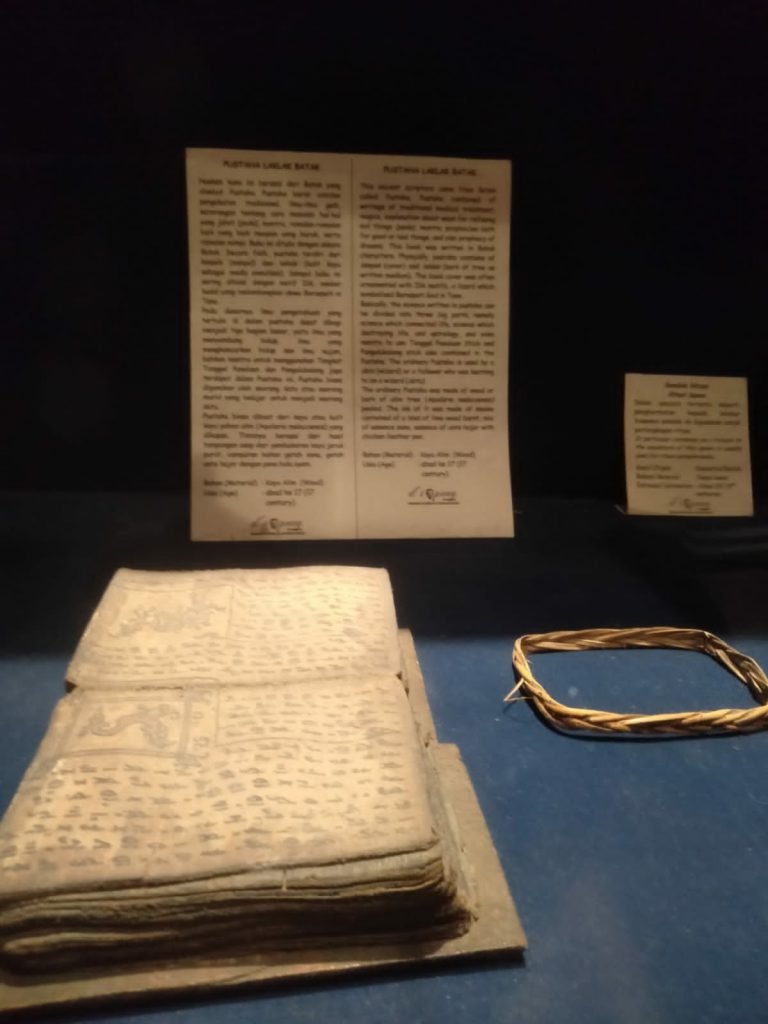
This book contains the meaning of several spells to cure various kinds of diseases, very few Batak people today can read the meanings and pictures in this Pustaha Lak Lak book, a book made using tree bark and natural ink from plant colors.
Makyong Mask

The Makyong mask is a mask that is used to dance when the harvest season arrives, the Makyong mask is in the form of a bird with a long beak which means happiness when getting a big harvest and defeats birds that are pests and enemies of farmers. Makyong dance performances can also be found in the traditions of the Malay people.
Brick Window

Used as a window for a traditional house with the motive of parents protecting the family. Wood as a material for making windows means simplicity and family function.
SULAWESI
Graveyard Door
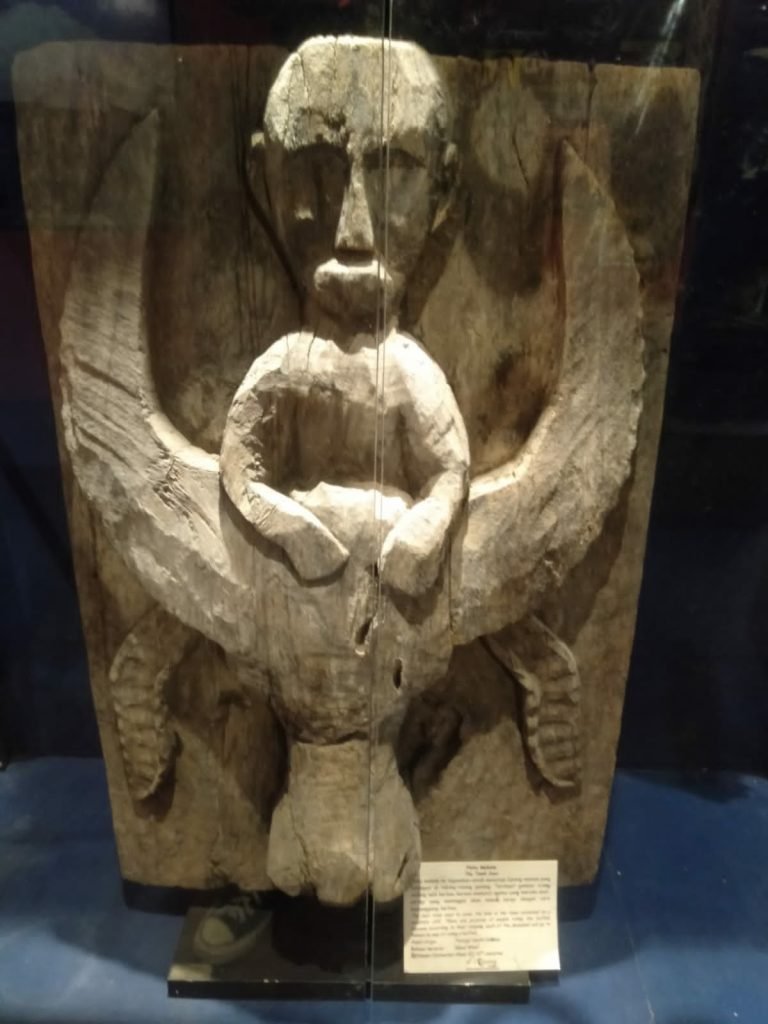
This buffalo-carved tomb door tells of a spirit that rides a buffalo to heaven, the buffalo is a sacred animal in the Toraja area so the buffalo carving on the cliff tomb door makes a prayer that the buffalo sacrificed in a funeral has become a vehicle to heaven.
Taoist Statue

The Taoist statue is a statue depicting a corpse in a cliff tomb. This wooden statue is placed on a rock cliff or beside the grave according to the level of the body’s social status. In addition to the social level, some Taoist statues are also brought closer to other Taoist statues, which are still one relative.
Death Mask

This mask is used for traditional funeral rituals for Toraja people who have high social status, especially traditional leaders and rich people who have many buffalo bows in their tongkonan houses.
Tedong Bonga
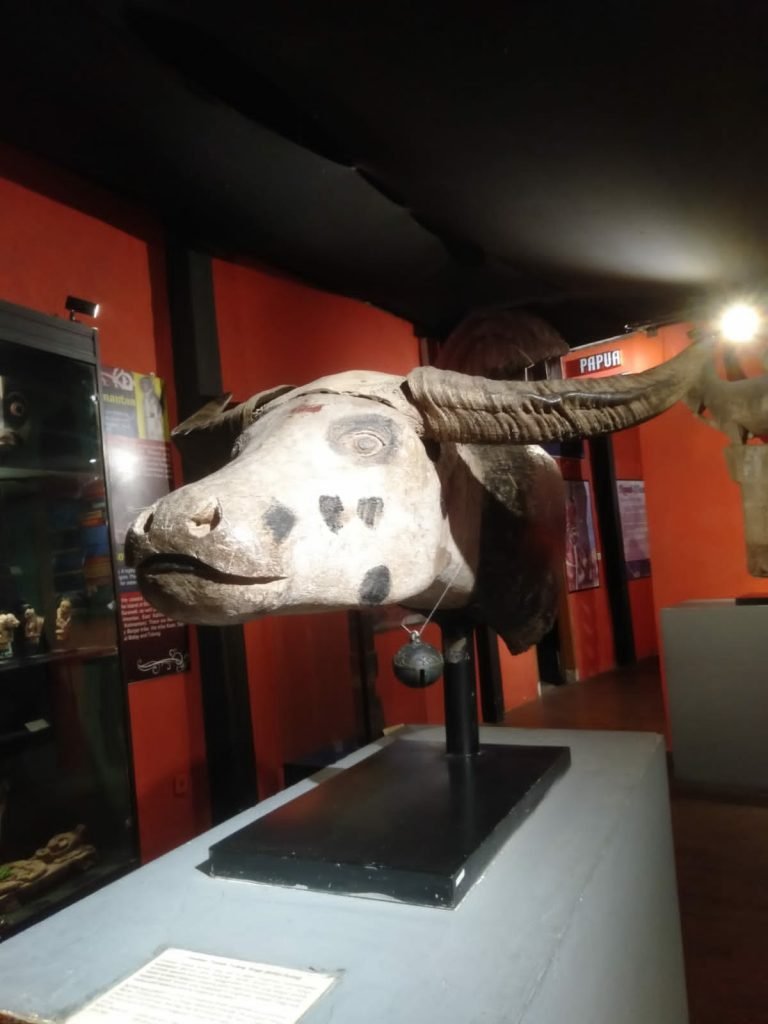
Tedong bonga is the horn of a Caucasian buffalo, a white buffalo typical of Sulawesi which is of fantastic value / expensive which is used by the Toraja people for funeral rituals, the number of horns depicts the wealth of the family which is shown on the tongkonan in front of the house. The price of one buffalo is 500 million to 1 billion rupiah
Yassin Sylling Coin

This gold coin has the Yassin letter carving on the coin, apart from being used to spread Islam, this coin is also used as a medium of exchange for society, so the buying and selling of the people of Sulawesi, the kingdom of Gowa, uses coins that contain blessings.
KALIMANTAN
Pantak Pandagi Statue

This statue is made using strong old Ulin wood, used as a statue of a village guard from danger and protector of villagers from disasters and so on, the shape of the branched wood shows the age of Pantak Pandagi which can last up to thousands of years.
Bottle Cover

This bottle cap is a bottle cover that is made and carved by Dayak tribe men according to their interests and preferences, sometimes the faces of family members or pets, this bottle cap is a lid for a drinking bottle made of green pumpkin, and is used as a provision for drinking when they are hunting animals in the middle of the forest because they often cannot find a spring.
Chief’s Chair

The chief’s chair is in the shape of a tortoise which means long life and blessings, the shape of the chair identifies the chiefs so they are not negligent and stay alert, because an attack can come at any time, so the chief’s chair is not made with a comfortable shape or soft cloth and so on, made small and without a backrest so that the chief is always alert.
Sapundu

Sapundu is a tool for hanging animals hunted by Dayak men, sapundu is used to drain animal blood or celebrate hunting success by displaying hunted animals in public when they are about to be cooked into a joint meal.
PAPUA
Perisai Asmat

The Asmat shield is a typical shield of the Asmat tribe in Papua, the shape of the shield covers the entire body with an ornament on the shield depicting loved family members, the Asmat shield also flows with blood to make it a strong and blessed shield.
Statue of Will

This statue tells the story of daily activities which are illustrated by the statue which is carved without joints, the statue of Kewenak is carved from a single tree wood so that the average statue is tall, the benefits of the statue are like photos, capturing moments.
Statue of Asmat’s Power

This statue tells the story of daily activities which are illustrated by the statue which is carved without joints, the statue of Kewenak is carved from a single tree wood so that the average statue is tall, the benefits of the statue are like photos, capturing moments.
WAYANG
Wayang Golek

This puppet is popularly known as wayang golek. wayang golek became known to the people of West Java in 1533 AD based on the Batutulis inscription. However, there is another opinion which states that wayang golek became known in West Java during the reign of Raden Patah from the Kingdom of Demak.
Wayang Kulit
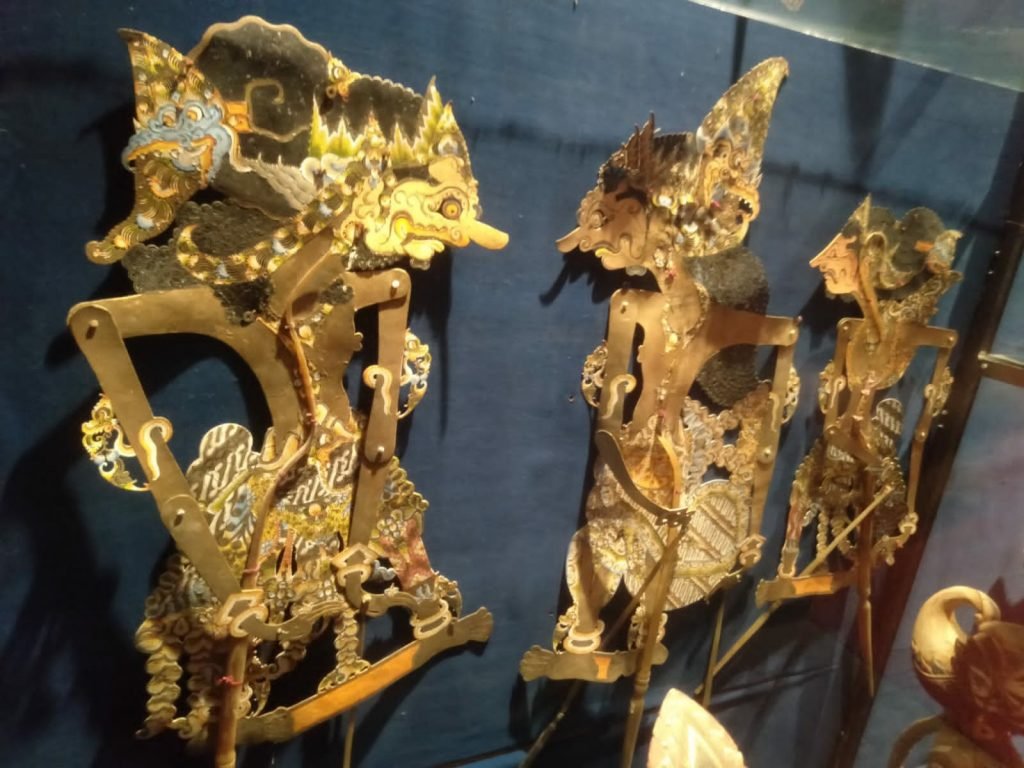
Wayang kulit is a traditional Indonesian art which mainly develops in Central and East Java. Wayang comes from the word “Ma Hyang” which means towards a spiritual spirit, god, or God Almighty. There are also those who interpret wayang as a Javanese term which means “shadow”, this is because the audience can also watch the puppet from behind the screen or only its shadow.
Wayang Pegunungan

Gunungan is a puppet in the form of a picture of a mountain and its contents. Below it is a picture of a gate guarded by two giants holding swords and shields in front of the palace gate. On the top of the mountain there is a wooden tree that is entwined by a dragon. Gunungan wayang sadat has a function as an opening and closing in the performance or serves as a singget boundary. In wayang sadat performances, wayang and gunungan are not taught to go right and left (like wayang purwo, but they are simply stacked in a box). Gunungan wayang sadat in the middle depicts a Demak mosque and is inscribed with the sentence of shahada.
Wayang Potehi

Wayang Potehi is a type of typical Chinese puppet originating from southern China. This art was brought by ethnic Chinese immigrants to various parts of the archipelago in the past and has become one of the types of Indonesian traditional art.
BATIK
Parang Kelytic Batik
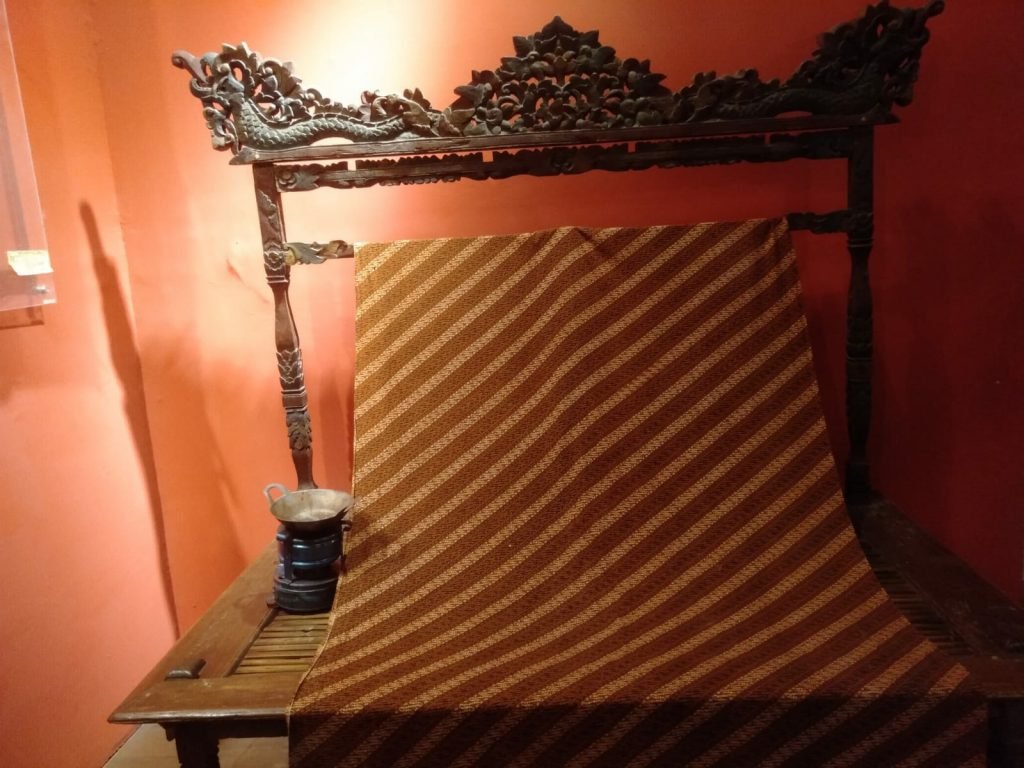
Parang Klithic is a machete pattern with a subtle stylization. the size is smaller and also depicts a feminine image. This motif symbolizes gentleness, refined behavior and wisdom. Usually used by princesses.
Batik Cap

Stamped batik is a type of batik production process that uses a canting stamp. The canting stamp referred to here is similar to a stamp, only the material is made of copper.
Batik 3 Country
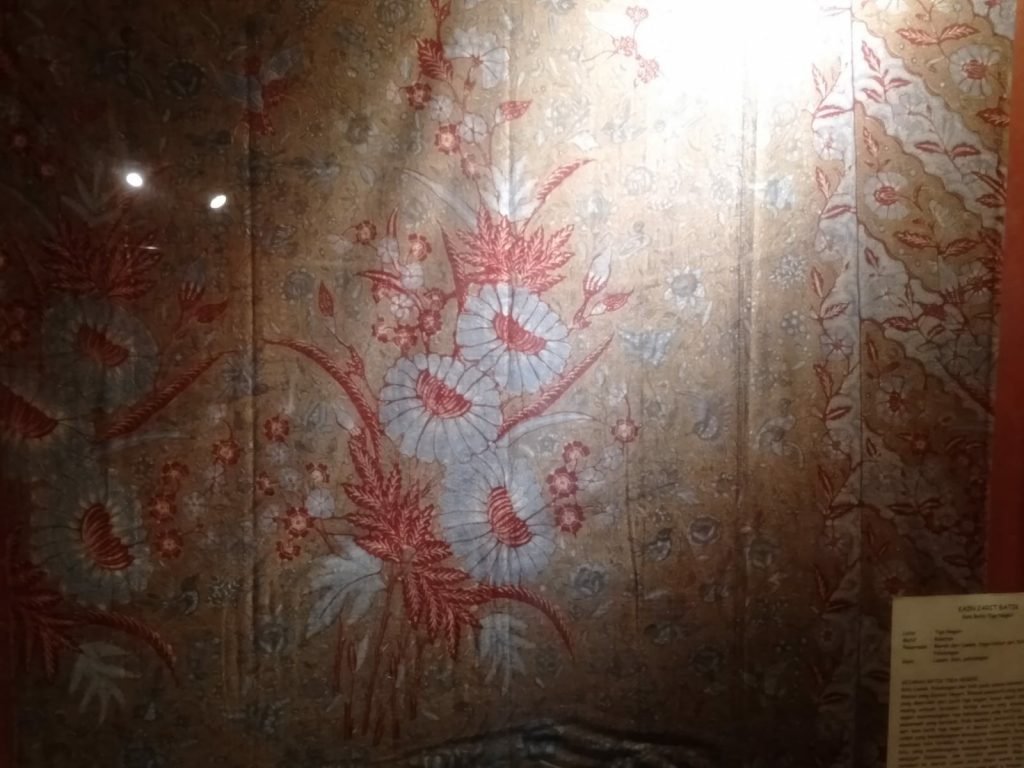
The red color of the batik from the three countries was influenced by the Chinese community in the past. Which has a symbol of happiness because it is often used at weddings,” he explained. Then, the blue color came from the Dutch, influences from European nations. Meanwhile, the brown color of soga is synonymous with Javanese culture.
Loro blonyo Jogja
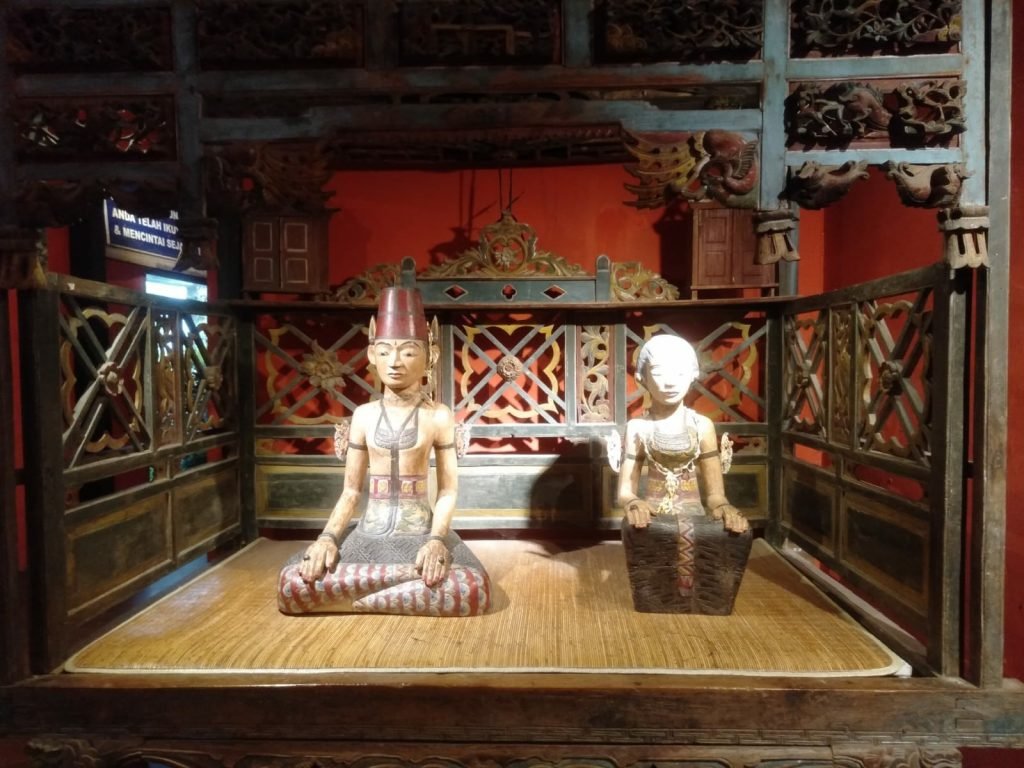
Loro Blonyo is a symbol of a happy married couple, Loro Blonyo is a statue that became a wedding photo in ancient times, Loro is taken from the Javanese language which means two and Blonyo which means makeup.
CHENGHO
Who is Admiral Chengho?

Cheng Ho or Zheng He, was a famous Chinese sailor and explorer. Among his explorations were 7 expeditions to the Archipelago and Taiwan between 1405 and 1433. Admiral Chengho brought a lot of Islamic influence into the Archipelago and various sciences and knowledge in the fields of astronomy, agriculture, maritime affairs and much more.
Admiral Chengho Birth: September 23, 1371, Yunnan, China
Died: 1433, Kozhikode, India
Child: Zheng Wenming
Siblings: Ma Wenming
Chinese Batik
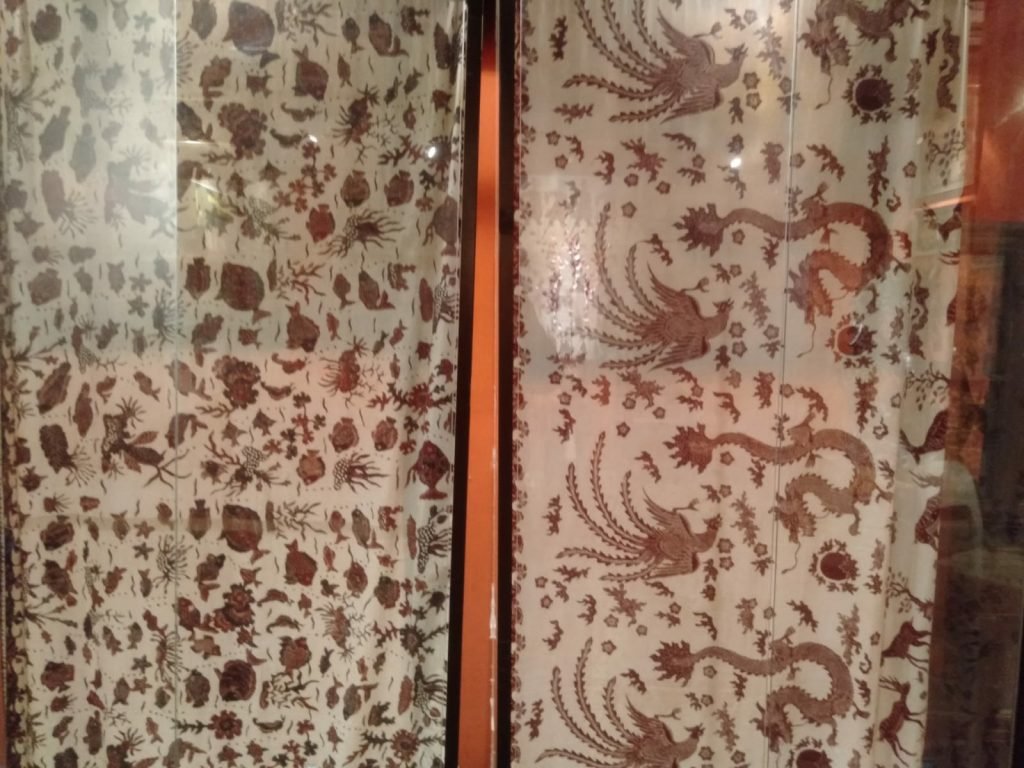
Batik (là rǎn 蜡染) is a technique of dyeing with wax that is used on textile base materials. Chinese batik is usually called (là rǎn 蜡染). The inventors showed that batik is the originality of Chinese ancestors, the red color is still the main characteristic of batik originating from China.
Dragon Statue
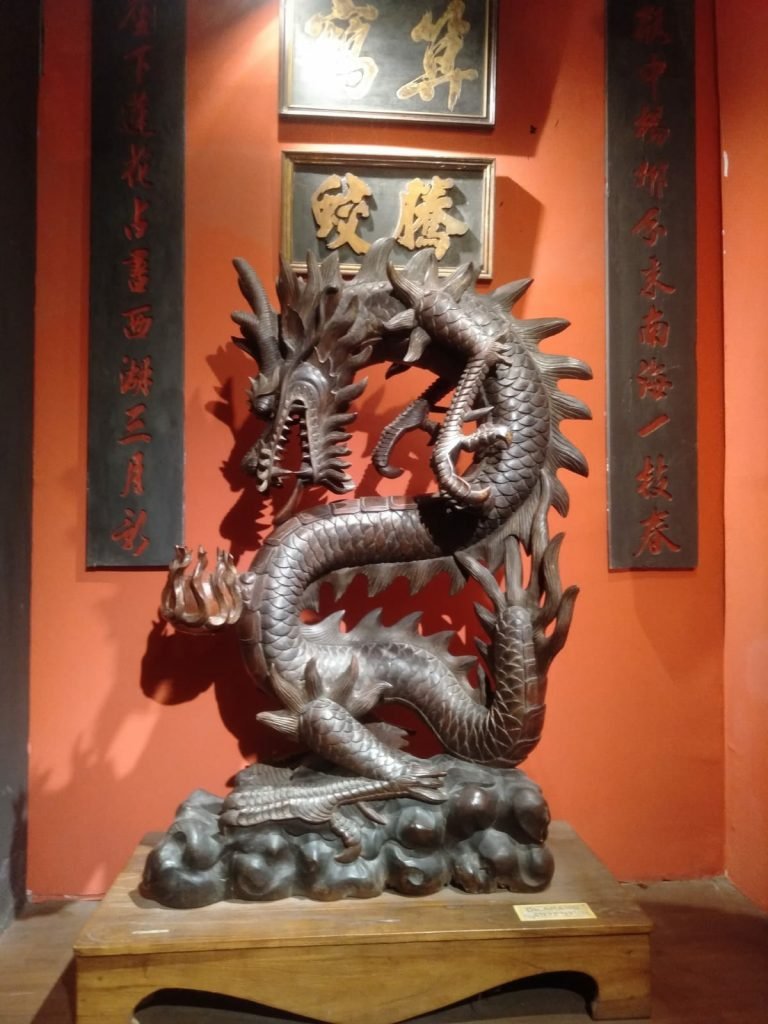
Dragon statue made using Quan Zhi wood, sturdy wood from China that is hundreds of years old, this dragon statue was once placed on the altar of the temple terrace, telling the story of dragons flying above the clouds.
Chinese Ceramics

Chinese ceramics left by ChengHo as souvenirs for regional heads he visited for business as well as spreading Islam, there are many Arabic carvings on the relics of Admiral ChengHo’s era because he was a devout Muslim.
SINGOSARI
Ganesha statue

Lord Ganesha or often also called Ganapati or Winayaka is a god whose embodiment is a mixture of elephants and humans. As is well known, Ganesha is a god who has the head of an elephant and has a human body.
Closing

Such is the adventure of the Indonesian Heritage Museum with its various collections of Indonesian Archipelago cultural heritage which are captivating and unforgettable.
Thank you for visiting BP, ladies and gentlemen.
Greetings culture.